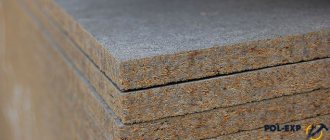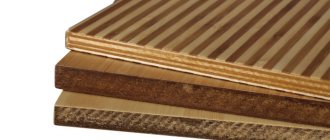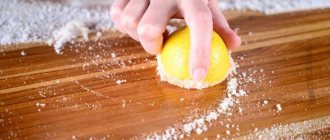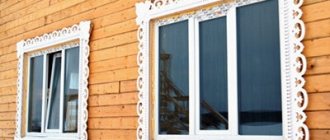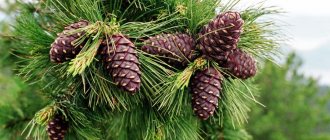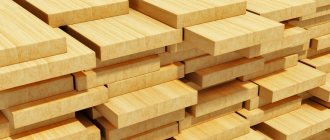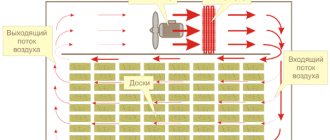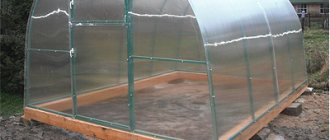In the field of construction and when carrying out repair work, along with natural materials, artificial ones are used, which contain various additives. There is a lot of discussion about the health hazards of OSB boards. There is an opinion that for safety reasons it is better not to use such finishing indoors, the material contains toxic substances.
What is OSB
Popular building materials include OSB (oriented strand boards), which are used for cladding interior spaces, as well as for creating partitions. Now such products have practically replaced plywood in the segment of wood-based building materials.
The boards consist of natural wood chips. In the process of their production, a large fraction is used, which remains as waste in the production of wood building materials.
Basically, slabs are created from coniferous wood by pressing at a temperature of 200 ºС. Special adhesives are added to small wood chips, which help to form webs of the desired parameters with different front surfaces.
Basic characteristics
OSB boards are almost 90% composed of wood chips, and the remaining 10% are waterproof components. Under the influence of high pressure, the output is a building material with a perfectly flat surface, without knots or defects. The sheets are more elastic and durable compared to regular wood.
The basic characteristics of OSB (Strand Orient Board) boards include:
- convenient sizes - from 1 to 2.8 meters in length;
- high strength;
- ease of processing;
- bending, tearing and compression rigidity;
- light weight;
- perfectly flat surface;
- noise and thermal insulation.
When completely immersed in water for a day, 6 to 25% of the material swells. When there is a difference in humidity and temperature, the coefficient of change in geometric dimensions is quite low. Such characteristics make it possible to use OSB boards in industry, but most often in construction.
Kinds
There is now a lot of debate about the health hazards of OSB boards, the technical characteristics and harmfulness of which depend on the type and composition of the products. The material is marked in the form of numbers from 1 to 4, indicating the degree of its moisture resistance, strength, as well as the number of adhesive components in the composition.
Manufacturers offer 4 types of oriented strand boards:
- OSB 1 - rather thin sheets intended for the construction of temporary structures, packaging, and the manufacture of furniture blanks;
- OSB 2 - used in interior spaces with a maximum air humidity of 60%, often used for rough work inside buildings, suitable for leveling floors, ceilings and walls, primary cladding;
- OSB 3 is a moisture-resistant material, excellent for finishing work indoors and outdoors, used as a leveling layer for finishing under plaster, brick, siding, thermal panels and other types of curtain walls;
- OSB 4 is reinforced boards with increased density for the formation of load-bearing structures; due to their high moisture resistance and strength, they are not afraid of heavy loads.
The board labeled OSB-3 is considered the most popular. It is universal, therefore suitable for most construction and finishing works.
Production technology
To understand how OSB can affect health , you need to know production technology. Particular attention should be paid to the components of the future material. The use of one low-quality component spoils the product as a whole.
Production stages:
- Receipt of raw materials and their processing. The main component of OSB boards is waste from the wood processing industry - non-business wood that was rejected. Wood waste is soaked at a certain temperature and cleaned.
- Slicing. At this stage, wood chips are obtained from waste by machine.
- Drying. The resulting raw materials are dried, which takes some time. If the chips dry out quickly, they may cause damage.
- Mixing. To bind wood chips, a composition of glue and resins is added to it, and other binding components may also be present in different volumes.
- Laying. Using molding machines, the mixed component is laid in several layers. Each subsequent layer is laid perpendicular to the previous one.
- Pressing. The resulting mass is compressed by a press and cut to a given size.
The main component of OSB boards is wood chips. This is an environmentally friendly component. The adhesive composition can be dangerous because it often contains formaldehyde resins.
Natural wood can also emit acceptable levels of formaldehyde. Therefore, talking about the safety of fresh wood is a controversial issue. But since wood chips for OSB have been processed, they are considered safe.
Manufacturers who value their customers and reputation claim the safety of the material. According to them, high quality OSB is achieved through endurance, and not through the power of the press. The press only gives the shape, and the chip material is bonded with resins over time. Since the binding period is long, formaldehyde has time to erode from the structure of the boards. The concentration of the substance drops, and it does not have a negative effect on human health.
Toxic components
To impart increased strength and increase moisture resistance, manufacturers use adhesives in the boards. These components release toxins that are hazardous to health into the air. However, during the manufacturing process of the material, the volume of phenols used is strictly limited. The exact quantity must be indicated on the products so that the buyer knows what type of product is safe to use indoors.
During the sheet pressing process, the following synthetic components are used that emit harmful fumes:
- phenolics;
- formaldehyde;
- methanol
In addition to the listed fumes, benzene is also present, which is a poisonous gas. Previously, ordinary PVA glue was used to glue wood chips. It is considered safe, but due to its high cost, it has ceased to be used, since the finished canvases are expensive.
Impact on the body
When exposed to intense high temperatures, OSB boards are harmful to human health. Synthetic resins begin to release toxic substances. For example, melanin is often used in glue and tannins, but its carcinogenic properties are negligible. It is dangerous only in its pure form.
Urea is used in boards to increase the adhesiveness of the material. It imparts strength in the thinnest layers of sheets.
Phenol poses an increased risk because it is very toxic to people and the environment. If the concentration is significantly exceeded, this substance penetrates the skin into the body and causes paralysis of the respiratory center.
Why are they dangerous?
Small amounts of formaldehyde are now used in various areas of production. In excess amounts upon contact with skin, it exhibits its toxic properties.
Such components are classified as allergenic, carcinogenic and mutagenic substances. They provoke the development of skin diseases and negatively affect the functioning of internal organs. The respiratory, cardiac and reproductive systems, organs of vision, and blood vessels suffer from them. Formaldehyde causes headaches and depression, and in severe poisoning, nausea and vomiting occur.
Even with short-term exposure to high concentrations of toxic substances on the human body, the respiratory system, mucous membranes, skin and nervous system are affected. If they are present in everyday life in small doses for a long time, they immediately become the cause of rhinitis, chronic bronchitis, asthma and lung problems. With prolonged contact with toxins, the risk of developing cancerous tumors in the nasopharynx increases.
Impact of modern technology
On the construction market there are OSB sheets without phenol. Manufacturers claim that they do not contain adhesives. Some factories have begun to use another polymer binder in production - methylene diphenyl diisocyanate.
Chemically unstable substances in building materials are replaced by more inert ones, as well as filler resins. The latter reduce the level of formaldehyde emissions.
What harmful substances are contained in OSB and how do they get there?
These boards are made by heat pressing large-sized shavings (small chips) of coniferous wood, laid in layers and oriented layer-by-layer. The multidirectional orientation of chips in different layers provides increased strength and rigidity of the material, due to which OSB is widely used in construction (cladding house frames, laying subfloors, formwork production, production of SIP panels), in furniture production, in the manufacture of containers, etc. .
Special adhesives are used as a wood pulp binder in the production of OSB boards, the main components of which are various synthetic resins - melamine-formaldehyde, urea-formaldehyde or phenol-formaldehyde. From the name of all these resins, it is easy to guess that one of the reagents in their synthesis is formaldehyde. This means that each resin, depending on its quality, contains one or another amount of unreacted aldehyde.
Free formaldehyde can also be released as a result of partial depolymerization of the resin, which occurs under the influence of high (up to 200°C) temperatures at which the process of pressing glue-impregnated chips is carried out. A significant part of this toxic substance will evaporate already in the production shops, but the residues will “ooze” out of the finished slab for a long time: the level of formaldehyde emission is halved within about six months from the date of production.
The release of formaldehyde also occurs during the operation of OSB boards: the slow destruction of formaldehyde resins (and primarily less persistent urea-formaldehyde resins) can be a consequence of exposure to various unfavorable environmental factors - moisture, elevated temperature, ultraviolet rays.
To be fair, it should be noted that the source of formaldehyde can be not only synthetic resin, but also wood itself, traditionally considered the standard of environmental friendliness. Formaldehyde emissions from freshly harvested wood can reach 0.2 mg/m3. With proper drying of lumber, this indicator decreases and becomes significantly lower than the background created by low-quality synthetic glue.
Certificates and norms
The cause of dangerous diseases can be not only building materials, but also other interior items. The health hazards of OSB boards are sometimes less than those of some pieces of furniture. For this reason, it is worth conducting a full study of the indoor air and environment.
According to sanitary and hygienic standards of the Russian Federation, the maximum permissible concentration of formaldehyde is 10 ml per 100 g of dry mixture. European standards are more stringent, so their norm is 8 ml with a maximum concentration in the air of no more than 0.003 mg/m3.
For enclosed spaces it is:
- single dose for 30 minutes - 0.005 mg/m3;
- average daily - 001 mg/m3.
It is necessary to request from sellers a product certificate that contains all technical characteristics. For each batch of sheets, a conclusion or certificate is issued after passing a sanitary and hygienic examination.
Be vigilant when purchasing
Financial affairs have not been going well for domestic consumers lately. As a result, people try to purchase material at a low cost, but a low price may indicate poor quality of the material. It will contain formaldehyde in a significant amount, which clearly exceeds the permissible standards.
Therefore, when purchasing glued material, you should pay attention to the following characteristics:
- Presence of a pungent odor. Toxic glue gives off a sharp, unpleasant odor that goes into the nose.
- Availability of a certificate. Each seller must receive this document from the manufacturer. Sometimes the procedure may be voluntary, but a conscientious manufacturer will still provide documentation.
- Product labeling. Each sheet must be marked. For OSB boards, the technical characteristics are as follows: the indicator of harmfulness to humans is indicated at the end.
- Price. The low price of the material, as well as sale on a spontaneous market from an incomprehensible seller, will not provide any guarantees regarding quality or safety.
If something is suspicious, it is better not to purchase such material. By paying more for a quality product, the consumer protects his health. This is especially true for young children.
Actions after purchase
Lucky is the one who read the article before going to the store. These readers can think about their decision, weigh the pros and cons.
The release of formaldehyde does not continue indefinitely - eventually its concentration in the material drops to a safe level, even in material that was manufactured in violation of environmental standards. But to do this you will need to do the following:
- Ventilate the material before installation until the characteristic pungent odor disappears completely. The same must be done with the room if the installation has already been completed. Airing will take a little longer.
- The surface of the material must not be wetted with water. Because of this, formaldehyde is released more strongly - in proportion to the increase in humidity.
- The room temperature should not exceed 30 degrees.
- If clothes smell toxic, they should be washed thoroughly several times.
If you don't mind the money, you can buy an air purifier with a photocatalytic filter, or at least rent it for a week or two. Such a device is capable of neutralizing a toxic substance from the air in a short time.
To know for sure whether the installed OSB board is harmful to health, there is a proven and reliable method. You will need an aquarium with fish. It must be installed in a room with OSB material. If the concentration of formaldehyde in the air exceeds the permissible limit, then the fish will not survive.
Dieffenbachia is an indoor flower that can absorb toxic substances from the air. Its presence will help reduce the amount of formaldehyde.
How to choose the most environmentally friendly stove
OSB facing materials are not always equipped with a quality certificate. This is due to the fact that the products offered are inexpensive. For this reason, special attention should be paid to the environmental friendliness of the product. It is advisable to visually inspect it, taking into account the emission class of formaldehyde and other toxic substances specified in the accompanying documents.
Nowadays there are facing sheets labeled “Super E”. It is an almost natural, odorless material, and its formaldehyde content is the same as in natural wood.
Manufacturer's Warranties
Over the past 20 years, manufacturers have managed to reduce the level of emissions of harmful substances in OSB boards. Experts in this field believe that in the future the percentage of toxic elements will be even lower. It is planned to improve these indicators by replacing unstable chemical synthetic resins with inert ones.
Egger conducted a computer analysis and concluded that once the adhesive is fully polymerized, no emissions are released from the finished sheets. High-precision instruments were used in the research process. However, manufacturers prefer to adhere to the strict requirements of the standard.
Recommendations
To minimize the harm of manufactured sheets, it is advisable to buy them from trusted manufacturing companies. Branded canvases are manufactured according to the European standard with markings E1 and E0. This material indicates complete safety and can be used indoors.
Boards with indices E2 and E4 are not suitable for interior decoration; they are used only for arranging structures outside the building - laying the roof or external cladding of the frame.
How to check quality
There are ways to help you identify low-quality building materials yourself. It is advisable to carry out such an examination not in a cold room, but in a warm and closed one, immediately after opening the package.
When purchasing OSB fabrics, it is advisable to pay attention to the following indicators:
- odor - toxic substances almost always emit a strong and unpleasant odor;
- certificate - bona fide manufacturers must check the quality of their products;
- marking - indicated on each sheet on the end side, where all the main indicators are indicated;
- price - a cheap product most often does not meet safety and quality requirements.
Production process - what potential dangers do synthetic resins pose?
To understand whether commercially available OSB boards are harmful to health, it is worth understanding the production features in more detail. The structural rigidity of this type of material is several times greater than that of durable types of wood. It should be taken into account that the products have a budget price and are made largely from natural raw materials. The subject of dispute among experts is the composition that is used to polymerize the chips.
Each OSB board is a multilayer structure. The direction of the chippings in one layer is perpendicular to the direction of the other layer. Thanks to this, the material has excellent fracture properties. The use of synthetic resins causes the acquisition of “additional” rigidity by oriented strand materials, as well as “zero” bioavailability. OSB is not affected by fungus, mold and insects.
Multilayer construction of OSB boards
These qualities, along with their affordable cost, have made these slabs leaders in the modern construction market, especially frame and private house construction. The sheets are used for the construction of reliable structures and are used as formwork in SIP panels. For external purposes, special types of resins are used that provide moisture resistance.
OSB production is based on the following polymers:
- melamine-formaldehyde synthetic wax used to bond the outer layers;
- urea-formaldehyde resin used for the inner layers of the slab.
Some manufacturers use phenol-formaldehydes in production, which in theory, along with formaldehyde, emit toxic phenol. These substances were part of the chipboard of the USSR period, now this technology has been completely changed, and also meets modern environmental safety requirements.
Safety regulations
Despite the high class of environmental friendliness of OSB boards, formaldehyde continues to be released. However, this indicator can be minimized indoors. There are certain rules that reduce the risk of harm to health.
Experts advise not to buy furniture or building materials such as OSB, MDF, chipboard, fiberboard, artificial laminate and plywood for interior decoration.
If the house already has them, then they need to be insulated with coatings. For this use:
- paint;
- wax;
- putty;
- wallpaper;
- ceramic tiles.
Such cladding in several layers helps reduce dangerous concentrations. Particular attention is paid to the ends, since the most toxic fumes seep through them during the first time after purchase.
With increasing humidity and temperature, toxic substances are released in large volumes. For this reason, building materials made from wood chips should not be allowed to become too hot or over-moistened.
Another way to minimize the release of toxic gases is to install supply and exhaust ventilation. During normal daily operation, the system will ventilate the room well. Harmful components will not be able to accumulate inside the living space.
Impact on the body
A large number of chemical and biological studies have been carried out on the effect on human physiology. Is formaldehyde in your home harmful?
The results were disappointing: phenol-formaldehyde resin is harmful to the body. If you are in a room with a high content of formaldehyde, then:
- Depression, irritability, and headaches develop.
- Symptoms of poisoning such as nausea and vomiting appear.
- Complete loss of vision is possible.
- Respiratory arrest may occur.
- Loss of reproductive functions is possible.
Such symptoms can only develop with high concentrations of formaldehyde. If the dose does not exceed 0.05 ml/l, then there is no danger.
Plywood
Ordinary plywood is an equally popular building material. The main element that is included in its composition is wood, namely veneer. The layers of veneer are connected to each other using adhesive resins, formaldehyde, phenol, resorcinol. Well, if you want to choose plywood that would be the least safe, then choose the FBA marking. This type of plywood is not moisture resistant, but albumin-casein glue is used in its production.
This plywood is made from birch veneer, and is quite suitable for use in residential premises, and even in rooms where there is high humidity. Bakelite varnish, which is made using folmardehyde resins, is used as a binder. But very often stores offer plywood that is labeled FSF or FK. Both of these types are moisture-resistant plywood, but in the first case, phenol-formaldehyde glue is used, and in the second, urea-formaldehyde.
The classification of this plywood according to formaldehyde content per 100 g of dry sheet consists of three main groups.
- E0 - E1 - 6 mg -10 mg of harmful resins.
- E2 - 10-30 mg.
- E3 - 30-60 mg. (production until 1992)
To summarize, we can conclude that not a single class, not a single type of plywood can be suitable for use for interior finishing work in a residential building. This is explained very simply. If the temperature in the room rises, then the release of toxic substances harmful to the body also increases. Also, substances hazardous to health can be released when humidity increases.
Composition and characteristics of plates
OSB boards are made from wood chips, which have a specific arrangement and are glued together using synthetic resins. This product has high technical characteristics. Wood shavings are an environmentally friendly material, but the resins contain formaldehyde, which causes a lot of controversy about the safety of this substance. However, thanks to synthetic resins, the strength and rigidity of this building material is several times higher than that of the strongest types of wood. Due to OSB resins, boards are characterized by zero bioavailability. This means that they are not susceptible to mold and insects.
The composition of OSB panels includes polymers such as:
- Melamine-formaldehyde synthetic wax. It is used to fasten the outer layers of the product.
- Urea-formaldehyde resin. It is used for the inner layers of the product.
What is formaldehyde? Can it cause harm to human health?
Formaldehyde is a colorless poisonous gas with a pungent odor that begins to be released at the high temperature required for pressing boards. When inhaled, the gas causes great harm to the human body.
We advise you to study - Laying linoleum with your own hands - preparation, instructions for laying and cutting
Formaldehyde is used to make pesticides and wood preservatives. It has found application in the paint and varnish, leather and even food industries. Based on this, we can assume that formaldehyde is not so dangerous for humans. It is present in small quantities in the environment. So why does the question of the dangerous use of OSB boards constantly arise? The main question is the quantitative presence of this substance. The minimum concentration of gas does not harm the human body.
Briefly about the main thing
In recent years, oriented strand boards (OSB) have been increasingly used in private low-rise housing construction. Whether their use is harmful to health depends on the installation location and the quality of the material.
Any slabs are suitable for outdoor work, but for interior use or for making furniture, you should choose those that have the lowest emission class of harmful volatile substances that are part of the binder resins.
A high safety class can only be guaranteed by well-known manufacturers. But even in this case, OSB is subject to mandatory external finishing, which creates an insulating layer for toxins.
Formaldehyde and other hazardous substances
In fact, it is quite possible to make OSB boards from natural resins that are diluted with minor additives. But this technology is quite expensive and does not allow the production of the required volumes of material. Therefore, the adhesive mass is replaced with a mixture of formaldehyde, phenol and other toxic substances.
Their presence in the air leads to the following problems:
- The appearance of allergic reactions and frequent headaches.
- The occurrence of skin diseases.
- Difficulty breathing and constant watery eyes.
- General decrease in immunity.
High levels of formaldehyde and other hazardous substances in the air can lead to negative health effects.
A certain threshold for formaldehyde levels has been established. It is no more than 0.5 mg per m3.
On a note! The standards for substance content in air and material should not be confused. These indicators vary.
How to check quality
The presence of a certificate does not always indicate the environmental friendliness of the product and the integrity of the seller. Serious and time-tested companies should inspire trust - for example, Egger, which regularly conducts examinations confirming the environmental friendliness of its products.
Russian manufacturers often violate technology and reduce the cost of production, which negatively affects quality. Experts say that the most unsafe is the Chinese OSB board. The health hazard in this case is obvious, since the cheapest and most toxic resins are used in production.
You can identify low-quality products yourself:
- Before purchasing, pay attention to what the sheets smell like. Formaldehydes and phenols have a strong smell of formaldehyde or cheap plastic.
- Check with the seller for original quality certificates with blue seals from the manufacturer.
- Inspect the packaging. Serious companies put markings on it and place special inserts inside with information about the product.



